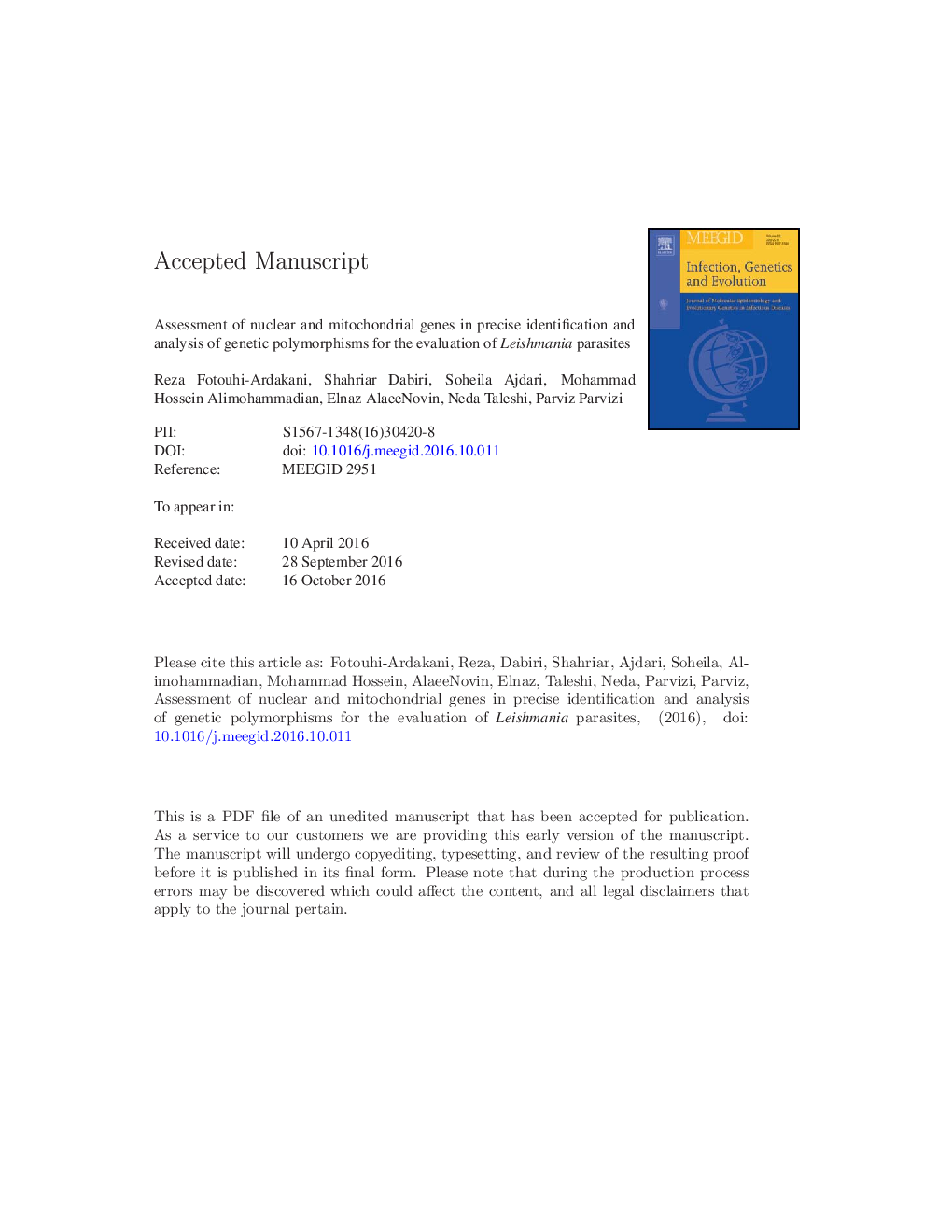| کد مقاله | کد نشریه | سال انتشار | مقاله انگلیسی | نسخه تمام متن |
|---|---|---|---|---|
| 5590689 | 1570157 | 2016 | 28 صفحه PDF | دانلود رایگان |
عنوان انگلیسی مقاله ISI
Assessment of nuclear and mitochondrial genes in precise identification and analysis of genetic polymorphisms for the evaluation of Leishmania parasites
ترجمه فارسی عنوان
ارزیابی ژن های هسته ای و میتوکندری در شناسایی دقیق و تجزیه و تحلیل پلی مورفیسم ژنتیکی برای ارزیابی پارازیت های لیشمانیا
دانلود مقاله + سفارش ترجمه
دانلود مقاله ISI انگلیسی
رایگان برای ایرانیان
موضوعات مرتبط
علوم زیستی و بیوفناوری
علوم کشاورزی و بیولوژیک
بوم شناسی، تکامل، رفتار و سامانه شناسی
چکیده انگلیسی
The polymorphism and genetic diversity of Leishmania genus has status under discussion depending on many items such as nuclear and/or mitochondrial genes, molecular tools, Leishmania species, geographical origin, condition of micro-environment of Leishmania parasites and isolation of Leishmania from clinical samples, reservoir host and vectors. The genetic variation of Leishmania species (L. major, L. tropica, L. tarentolae, L. mexicana, L. infantum) were analyzed and compared using mitochondrial (COII and Cyt b) and nuclear (nagt, ITS-rDNA and HSP70) genes. The role of each enzymatic (COII, Cyt b and nagt) or housekeeping (ITS-rDNA, HSP70) gene was employed for accurate identification of Leishmania parasites. After DNA extractions and amplifying of native, natural and reference strains of Leishmania parasites, polymerase chain reaction (PCR) products were sequenced and evaluation of genetic proximity and phylogenetic analysis were performed using MEGA6 and DnaSP5 software. Among the 72 sequences of the five genes, the number of polymorphic sites was significantly lower as compared to the monomorphic sites. Of the 72 sequences, 54 new haplotypes (five genes) of Leishmania species were submitted in GenBank (Access number: KU680818 - KU680871). Four genes had a remarkable number of informative sites (P = 0.00), except HSP70 maybe because of its microsatellite regions. The non-synonymous (dN) variants of nagt gene were more than that of other expression genes (47.4%). The synonymous (dS)/dN ratio in three expression genes showed a significant variation between five Leishmania species (P = 0.001). The highest and lowest levels of haplotype diversity were observed in L. tropica (81.35%) and L. major (28.38%) populations, respectively. Tajima's D index analyses showed that Cyt b gene in L. tropica species was significantly negative (Tajima's D = â 2.2, P < 0.01), while COII and nagt genes were produced through evolutionary processes for both L. tropica and L. major (Tajima's D = 2.85 & 2.91, P < 0.01). More different clinical lesions with extensive phylogenetic and evolutionary analyses should be employed to avoid confusion in the diagnosis of leishmaniasis and development of vaccines for eradicating Leishmania parasites.
ناشر
Database: Elsevier - ScienceDirect (ساینس دایرکت)
Journal: Infection, Genetics and Evolution - Volume 46, December 2016, Pages 33-41
Journal: Infection, Genetics and Evolution - Volume 46, December 2016, Pages 33-41
نویسندگان
Reza Fotouhi-Ardakani, Shahriar Dabiri, Soheila Ajdari, Mohammad Hossein Alimohammadian, Elnaz AlaeeNovin, Neda Taleshi, Parviz Parvizi,
